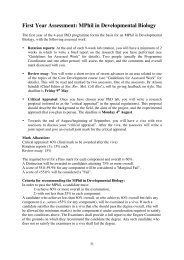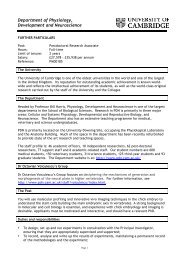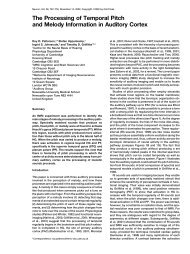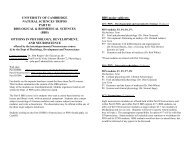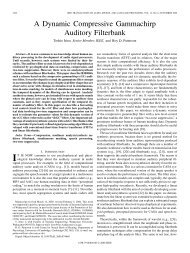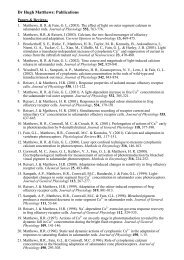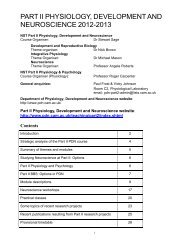Self-report outcome in new hearing-aid users - Department of ...
Self-report outcome in new hearing-aid users - Department of ...
Self-report outcome in new hearing-aid users - Department of ...
You also want an ePaper? Increase the reach of your titles
YUMPU automatically turns print PDFs into web optimized ePapers that Google loves.
Increase <strong>of</strong> score (% po<strong>in</strong>t)<br />
40<br />
20<br />
0<br />
-20<br />
-40<br />
Discussion<br />
First-timers w/HA-use<br />
Control<br />
GHABP IOIHA HAPQ SADL<br />
Figure 4. As Figure 3 for first-time <strong>users</strong> with more than four<br />
hours <strong>of</strong> daily hear<strong>in</strong>g-<strong>aid</strong> use, compared to a control group <strong>of</strong><br />
experienced <strong>users</strong>, and <strong>aid</strong> <strong>users</strong> with less than four hours <strong>of</strong><br />
daily hear<strong>in</strong>g-<strong>aid</strong> use.<br />
This section focuses on three dist<strong>in</strong>ct aspects <strong>of</strong> the results,<br />
namely the validity <strong>of</strong>, the relations between, and acclimatization<br />
effects <strong>in</strong>, the different measures <strong>of</strong> self-<strong>report</strong> benefit and<br />
satisfaction.<br />
Validity <strong>of</strong> subscales<br />
When an item contributes <strong>in</strong>consistently to a (sub-) scale, this<br />
can happen because the word<strong>in</strong>g is not good (low convergence<br />
or content validity), or because the item addresses an attribute<br />
that the hear<strong>in</strong>g-<strong>aid</strong> <strong>users</strong> are not able to appreciate (no face<br />
validity).<br />
IOI-HA item 5 was found to contribute <strong>in</strong>consistently to the<br />
subscale IOI-IA. The attribute addressed <strong>in</strong> this question<br />
belongs <strong>in</strong> the category residual disability (as <strong>in</strong> GHABP-R),<br />
<strong>in</strong> which the hear<strong>in</strong>g-<strong>aid</strong> <strong>users</strong> are expected to quantify rema<strong>in</strong><strong>in</strong>g<br />
disability when wear<strong>in</strong>g hear<strong>in</strong>g <strong>aid</strong>s compared to not hav<strong>in</strong>g<br />
hear<strong>in</strong>g difficulties. It is argued here that this may not be a viable<br />
task because the reference for residual disability is normal<br />
hear<strong>in</strong>g. This basel<strong>in</strong>e may not be available to <strong>users</strong> whose<br />
hear<strong>in</strong>g loss has progressed over a substantial number <strong>of</strong> years,<br />
which is <strong>of</strong>ten the case <strong>in</strong> presbyacusic patients. While this<br />
problem concerns content validity, another problem with IOI-<br />
HA item 5 is the complexity <strong>of</strong> the word<strong>in</strong>g. The item asks about<br />
the degree to which hear<strong>in</strong>g difficulties affect the th<strong>in</strong>gs the<br />
hear<strong>in</strong>g-<strong>aid</strong> user can do, but <strong>in</strong> the Danish translation the words<br />
‘over the past two weeks with your present hear<strong>in</strong>g <strong>aid</strong>s’ form a<br />
subord<strong>in</strong>ate clause that separates semantic subject from object <strong>in</strong><br />
the ma<strong>in</strong> clause. This might cause some respondents to<br />
accidentally switch the semantic subject <strong>of</strong> the question. Thus,<br />
there is a risk that the item is misunderstood to be ask<strong>in</strong>g the<br />
degree to which the hear<strong>in</strong>g <strong>aid</strong>s affect the th<strong>in</strong>gs the user can do.<br />
If this happens (and if the hear<strong>in</strong>g <strong>aid</strong>s are any good), the scale<br />
orientation is reversed and that could expla<strong>in</strong> the negative itemtotal<br />
correlation.<br />
SADL item 7 was not understood by most respondents. The<br />
item addresses the compromise between avoid<strong>in</strong>g acoustic feedback<br />
and obta<strong>in</strong><strong>in</strong>g adequate ga<strong>in</strong>. All audiologists know that<br />
this compromise is pert<strong>in</strong>ent for some <strong>users</strong>. However, if the<br />
hear<strong>in</strong>g <strong>aid</strong>s are well fitted and the ear-mould acoustics do not<br />
cause problems with feedback, then obviously the user is not<br />
bothered by feedback. For the item to be a sensitive measure <strong>of</strong><br />
the amount <strong>of</strong> bother caused by feedback, the respondent must<br />
know that there is a trad<strong>in</strong>g relationship between ga<strong>in</strong> and<br />
whistl<strong>in</strong>g, which is not necessarily the case for <strong>users</strong> <strong>of</strong><br />
<strong>in</strong>struments without a volume control. Thus, the item addresses<br />
a f<strong>in</strong>e-tun<strong>in</strong>g matter, not necessarily well understood by the<br />
average user <strong>of</strong> an automatic hear<strong>in</strong>g <strong>aid</strong>.<br />
The above illustrates the difficulty <strong>of</strong> compil<strong>in</strong>g items <strong>of</strong><br />
universal applicability. If the question was simply ‘are you<br />
bothered by feedback?’, then some <strong>users</strong> might answer ‘no’<br />
[‘but I have to turn down the volume so I can’t hear’]. In that<br />
case, we do not capture the true amount <strong>of</strong> bother caused by<br />
potential feedback. When the question is ref<strong>in</strong>ed to avoid that<br />
situation, it becomes so complex that people do not understand<br />
what it is about.<br />
Relationships between measures<br />
While the subscales <strong>in</strong> IOI-HA and SADL were <strong>in</strong>dependent and<br />
stable over time, those <strong>in</strong> HAPQ and GHABP were less so.<br />
Although it could be argued that there is no obvious reason why<br />
hear<strong>in</strong>g-<strong>aid</strong> <strong>outcome</strong> subscales should be <strong>in</strong>dependent, if a<br />
significant and strong correlation exists between any two<br />
subscales then there is no need to keep both, because they will<br />
convey the same <strong>in</strong>formation. This is not to say, however, that<br />
<strong>outcome</strong> scales should be free from between-item correlation. If<br />
the number <strong>of</strong> items is reduced, so as to handle a given attribute<br />
through fewer questions, the risk is an <strong>in</strong>crease <strong>of</strong> verbal<br />
sophistication <strong>in</strong> the rema<strong>in</strong><strong>in</strong>g items that may <strong>in</strong> turn decrease<br />
the sensitivity to the attribute <strong>in</strong> question, as illustrated above for<br />
SADL item 7. As such, there is a trad<strong>in</strong>g relation between<br />
achiev<strong>in</strong>g scale sensitivity and hav<strong>in</strong>g an efficient scale structure<br />
<strong>of</strong> <strong>in</strong>dependent subscales, <strong>in</strong> that from a cl<strong>in</strong>ical practice po<strong>in</strong>t <strong>of</strong><br />
view, it is desirable to avoid repeat<strong>in</strong>g essentially the same<br />
question because it makes the <strong>in</strong>ventory shorter.<br />
For HAPQ, the salience <strong>of</strong> the own-voice factor decreased<br />
dur<strong>in</strong>g the first 3 months post-fitt<strong>in</strong>g. Cl<strong>in</strong>ical experience<br />
suggests that while first-time <strong>users</strong> <strong>of</strong>ten <strong>in</strong>itially f<strong>in</strong>d it<br />
particularly troublesome that hear<strong>in</strong>g <strong>aid</strong>s change the sound <strong>of</strong><br />
their own voice (echo, occlusion effect, loudness or timbre<br />
changes), it becomes less <strong>of</strong> an issue after the benefits <strong>of</strong> us<strong>in</strong>g<br />
the hear<strong>in</strong>g <strong>aid</strong>s have been experienced.<br />
Overall, the factors identified <strong>in</strong> HAPQ did not all have high<br />
face validity. Before a subscale can be def<strong>in</strong>ed let alone<br />
labelled the contribut<strong>in</strong>g items must address issues that have<br />
someth<strong>in</strong>g <strong>in</strong> common, which was not the case for the factors<br />
derived from sessions 1 and 2. This suggests that early <strong>outcome</strong><br />
assessment might be spurious if a questionnaire uses many<br />
dist<strong>in</strong>ct dimensions. The results support the notion that early<br />
self-<strong>report</strong> <strong>outcome</strong> assessment is only valid if the questions have<br />
face value and do not address attributes that <strong>new</strong> <strong>users</strong> cannot<br />
be expected to handle.<br />
While between-subscales correlations were unexpectedly high<br />
for the GHABP, it is noteworthy that they changed with time.<br />
Thus, between benefit and satisfaction, the correlation went<br />
390 International Journal <strong>of</strong> Audiology, Volume 45 Number 7



